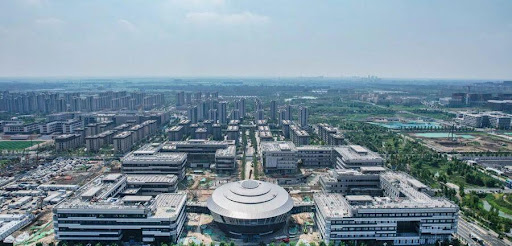By Zhang Tengyang, People’s Daily
At the construction site of the Xiong’an Energy Internet Innovation Center of China’s State Grid in Xiong’an New Area, north China’s Hebei province, cabling and interior finishing are proceeding in an orderly fashion. This is Xiong’an New Area’s first all-electric, smart, zero-carbon park.
The complex’s design features a circular layout, with a spherical conference and exhibition center at its core, surrounded by four research, development, and industrial buildings. The project is scheduled for completion by the end of 2025.
A notable architectural feature is the installed glass curtain walls. These panels are noticeably thicker than standard ones, measuring nearly 10 centimeters. “Each unit is composed of three glass layers with two cavities filled with argon gas, significantly reducing heat transfer,” explained Li Peng, safety manager for the project at State Grid Digital Technology Holdings Co’s subsidiary in Xiong’an.
“With over 8,000 such panels, the curtain walls form a highly efficient barrier that retains heat in winter, blocks it in summer, and optimizes natural lighting, thereby cutting energy consumption for heating, ventilation, and air conditioning (HVAC) and illumination,” he added.
But energy savings and carbon reduction require more than good insulation. Above and below ground, the park has installed a “circulatory system” to maintain stable temperatures.
“The park has drilled 1,136 geothermal wells, each exceeding 130 meters in depth,” Li said. “U-shaped pipes within these wells facilitate heat exchange with the surrounding soil, and geothermal pump units then transfer this thermal energy to the building’s internal water circulation system.”
This mechanism extracts heat from the ground to warm buildings during winter and dissipates excess indoor heat underground during summer, maintaining a stable internal temperature between 21 and 26 degrees Celsius. This method is far more efficient than conventional HVAC; calculations indicate that each kilowatt-hour of electricity consumed returns over five kilowatt-hours worth of heating or cooling effect.
Complementing this, the building rooftops are being fitted with photovoltaic (PV) panels. “Approximately half of the park’s rooftops will be covered with solar panels, generating electricity for on-site consumption,” said Xu Huiming, a smart energy expert at State Grid Digital Technology Holdings.
The PV system’s design takes building orientation and roof slope into full consideration to maximize energy capture. During periods of high solar generation and demand, all rooftop solar power will be consumed locally. The system’s annual PV output is expected to reach 2.73 million kilowatt-hours, covering a quarter of its electricity demand.
In addition to these physical infrastructure solutions, the park employs a smart “cloud-based” carbon management system. An integrated smart operations platform enables real-time monitoring and management of energy use, carbon emissions, and facility operations.
Wang Shuanghu, the platform manager, demonstrated a digital dashboard providing a panoramic overview of the park’s energy, facilities, maintenance, and safety.
The system manages an extensive network of 146,000 pieces of equipment, from air conditioners and faucets to lightbulbs, tracking their usage and electricity consumption in real time. It can calculate energy use and carbon emissions for every building, floor, and room. Supported by big-data analytics, the platform dynamically adjusts energy loads to ensure flexible and efficient operation. Wang illustrated this with the smart lighting system, which can be manually adjusted based on time of day, pedestrian flow, and ambient light levels.”
At the heart of the park, the conference and exhibition center is nearing completion, which will function as a direct-current, zero-carbon building. It is also planned to host a future electricity-carbon trading platform, serving as a hub connecting power consumers, enterprises, and energy markets.
These measures have already reduced the park’s carbon emissions by more than 60 percent. While the facility remains connected to the conventional power grid, a source of indirect emissions, Xu clarified the strategy: “Through our trading platform, we will directly purchase green electricity to offset these residual indirect emissions.”
Projections indicate the park will reduce carbon emissions by 3,370 tons annually through passive energy-saving designs and clean-energy stations; by 1,386 tons through smart lighting and efficient fixtures; by 541 tons through energy-efficient data centers and smart operations; and by 1,367 tons through rooftop PV generation. The remaining 4,104 tons of indirect emissions will be neutralized through the procurement of green power and carbon trading mechanisms, ultimately realizing the goal of net-zero carbon emissions.














